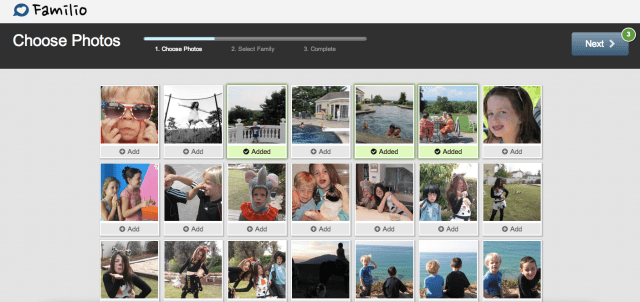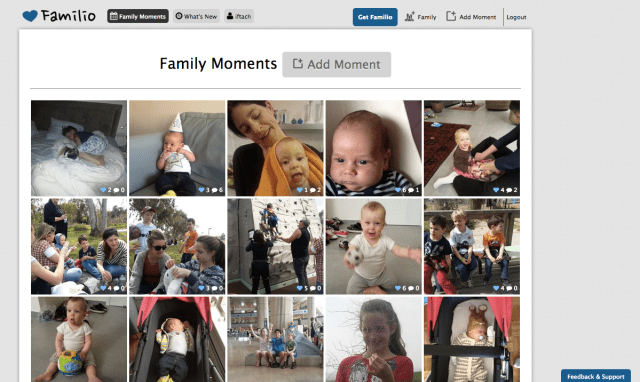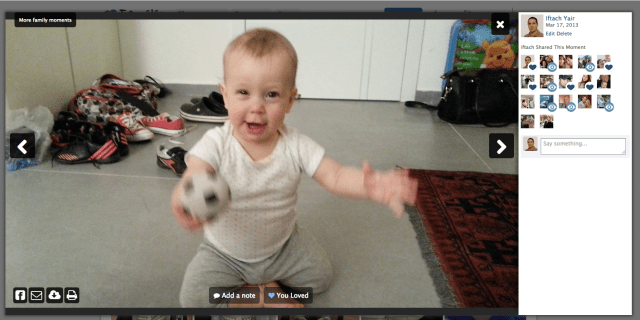Famil.io, a new service for privately sharing photos and videos with your family across web and mobile, is today officially launching to the public. The sharing platform can serve as a complement to Facebook, where most families network today, though in a more restrained fashion. Or for those family members who aren’t even active on Facebook, Famil.io can, to some extent, serve as a replacement.
The service works online, or as a web browser extension (initially for Chrome), and on iOS or Android. This cross-platform support was critical for Famil.io, CEO Iftach Yair explains.
Yair joined Famil.io, which is being incubated within Israel’s lool.vc, around six months ago to help co-founder Iftach (yes, also!) Orr bring the product to the market. Lool.vc operates in a similar manner to Betaworks here in the U.S., in that it funds and incubates startups, providing them with office space, resources and support.
“I took the basic project that was running and made a lot of changes in it,” explains Yair. “The major one was to take Famil.io from a destination site and an app, into a cross-platform, cross-generation product,” he says. “In order to make this product work, you have to make it agnostic of the platform or devices that your family is using. If you’re going to build a product for iPhones or Android, and look away from the desktop, then you’ll be leaving a good chunk of your family aside, and that will make your product unsuccessful,” Yair adds.
It’s a good argument, and one that’s especially applicable to my personal situation, because my own parents are Facebook holdouts. (My father is a state Court of Appeals judge, and it’s discouraged.) But in every family, there are those – often older members – who aren’t as active on Facebook than others. Famil.io finally includes them.
The website and Chrome extension are very simple to use, though someone might have to help the grandparents with the latter. During the private beta with some 7,000 users, the thing the non-technical users said they liked about the Chrome add-on is that it takes over Chrome’s “new tab” page, putting photos and updates from family directly in their browser. (For those like me who actually use the new tab page, not to worry – you can disable this in the Settings.)
Famil.io reminds me a lot of Familiar, which offers a strikingly similar service for photo-sharing, but one that revolves around screensavers, as opposed to an online application. As of year-end 2012, following its $1.3 million seed round from Greylock, Indx, Redpoint, Allen & Company, and others, Familiar said it had displayed over 200 million photos, and was seeing 135 percent month-over-month growth in November.
Sometimes the industry has trouble parsing services like this, which eschew chasing the “next big thing” to focus instead on the second wave of technology adopters. But these services can find their niche among those families looking for simpler solutions. When I stopped updating my Familiar briefly, for instance, my sister even called me to complain that she had no new photos of her niece.
Of course, going after the long tail isn’t a future-proof strategy for obvious reasons, but Famil.io has plans to offer a differentiated feature set in the future, which should have broader appeal.
Currrently, with Famil.io, the idea is that instead of screensavers, users can receive push notifications, not entirely different from Facebook’s own notifications, right in their web browser via the browser extension. This is helpful because on Facebook, users tend to miss a lot of their family photos because of the noise and the way Facebook’s news feed works, Yair says. “Some people think that by sharing on Facebook, everyone sees the photos, but the reality is that because of the Facebook Graph, only around 15 percent of photos are viewed at any time,” Yair claims. (Facebook’s news feed algorithms are always in flux, we should note, so these numbers tend to change. Still, the overall point – that things get missed – is accurate.)
He also adds that as people’s networks have expanded, they’ve grown less comfortable with sharing all their family photos on Facebook. “I don’t want to spam everyone with photos of my son,” Yair explains, giving a personal example. “This is an issue…most people don’t really care about other people’s kids that much.”
Oh yes.
Remember the UnbabyMe movement? This kind of takes care of that problem.
Currently, Famil.io’s platform supports high-res photo uploads from your computer or phone, plus support for photo imports from Facebook (for those that may have been missed). Videos are supported as well, and in the future, the company will add the option for sharing posts, also like Facebook. Users can comment on and like the shared photos and videos, too.
One of the more interesting things about the service is that everyone builds their own Famil.io groups – just because you’re invited to join a group with Aunt Sally in it, doesn’t mean that your spouse (who can’t stand the woman), has to have her in his group in order to see your shares. That’s different from how most group-based services work today – it’s more flexible.
The long-term goal is not just to mimic Facebook’s feature set, while serving a private audience – but to offer something tangible to its users. Famil.io plans to monetize by offering built-in, print-on-demand services for photo prints and photobooks, among other things, as well as a way to pay for “lifetime storage,” meaning secure, online hosting and easy-to-export data.
Pricing for these things has not yet been worked out. The service itself is free to use – sign up is here.



